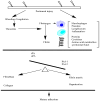Integrating Genomics and Molecular Biology in Understanding Peritoneal Adhesion
- PMID: 40699873
- PMCID: PMC12192355
- DOI: 10.3390/cimb47060475
Integrating Genomics and Molecular Biology in Understanding Peritoneal Adhesion
Abstract
Peritoneal adhesions following surgical injury remain a major clinical challenge, often resulting in severe complications, such as intestinal obstruction, chronic pain, and infertility. This review systematically integrates recent genomic and molecular biology insights into the pathogenesis of peritoneal adhesions, explicitly focusing on molecular pathways, including TGF-β signaling, COX-2-mediated inflammatory responses, fibrinolytic balance (tPA/PAI-1), angiogenesis pathways (VEGF, PDGF), and extracellular matrix remodeling (MMPs/TIMPs). Newly conducted transcriptomic and proteomic analyses highlight distinct changes in gene expression patterns in peritoneal fibroblasts during adhesion formation, pinpointing critical roles for integrins, cadherins, selectins, and immunoglobulin superfamily molecules. Recent studies indicate significant shifts in TGF-β isoforms expression, emphasizing isoform-specific impacts on fibrosis and scarring. These insights reveal substantial knowledge gaps, particularly the differential regulatory mechanisms involved in fibrosis versus normal reparative reperitonealization. Future therapeutic strategies could target these molecular pathways and inflammatory mediators to prevent or reduce adhesion formation. Further research into precise genetic markers and the exploration of targeted pharmacological interventions remain pivotal next steps in mitigating postoperative adhesion formation and improving clinical outcomes.
Keywords: adhesion; adhesion genes; peritoneum; peritonitis; reintervention.
Conflict of interest statement
The authors declare no conflicts of interest.
Figures


References
-
- Fometescu S.G., Costache M., Coveney A., Oprescu S.M., Serban D., Savlovschi C. Peritoneal fibrinolytic activity and adhesiogenesis. Chirurgia. 2013;108:331–340. - PubMed
Publication types
LinkOut - more resources
Full Text Sources
Research Materials

